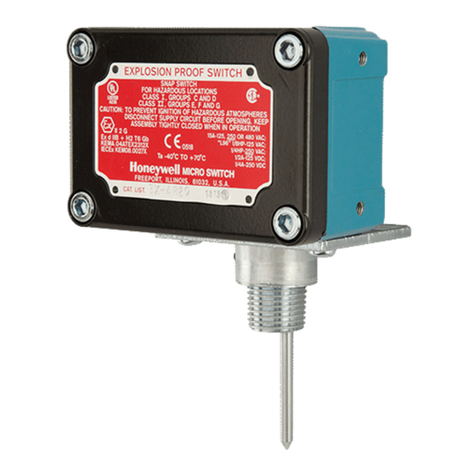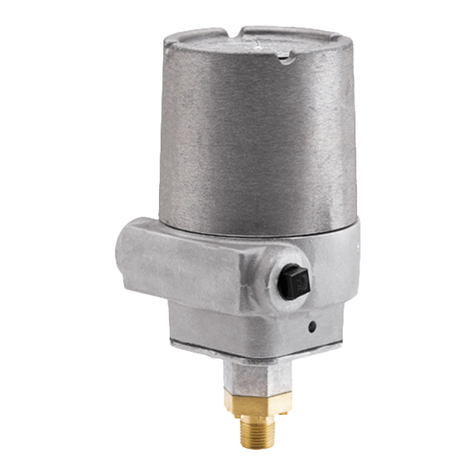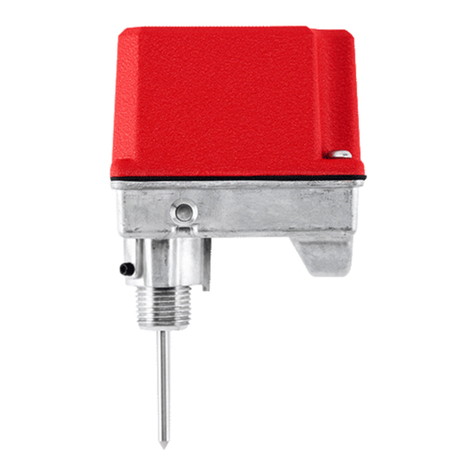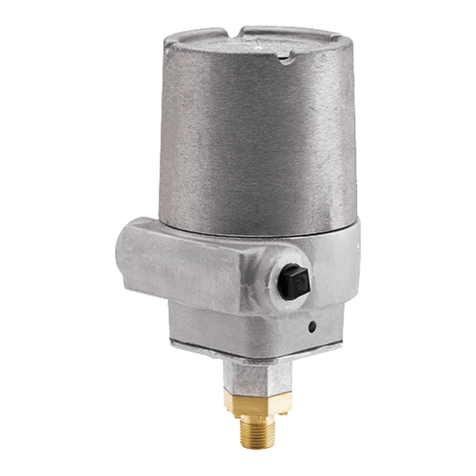
D770-17-00 3 I56-986-02
Adjustments To Factory Settings
Table 2.
FACTORY SETTINGS (PSI)
MODEL Fall SW2
(Low Switch) Rise SW1
(Hi Switch)
Nominal
EPS40-1
EPS40-2
EPS120-1
EPS120-2
30±1.5
30±1.5 ––115
101.5 - 112.5
101.5 - 112.5 117.5 - 128.5115
––40 50±2.540
Single-switch Model — EPS40-1 and EPS120-1
1. Install pressure switch as stated in “INSTALLATION”
portion of instruction manual. Attach pressure test
source to system.
2. Back off locking screw (see Figure 1) to allow main ad-
justment wheel to rotate freely.
3. Test the switch for the set point by introducing 40 PSI
pressure from the pressure test source for the EPS40-1
(115 PSI for the EPS120-1). Decrease pressure slowly un-
til the switch trips. Rotate main adjustment wheel, Fig-
ure 5, (counterclockwise to increase pressure) and retest
by first introducing a higher pressure than desired and
slowly reducing pressure until the switch trips. Repeat
process until switch trip point is at desired pressure set-
ting. Each number represents an approximate trip point
change of 1.8 PSI for the EPS40-1 and 6.6 PSI for the EPS
120-1. For each 1/2rotation of the adjustment wheel, the
trip point setting changes by approximately 11 PSI for
the EPS 40-1 and 40 PSI for the EPS 120-1.
4. Retest the set point several times to ensure accuracy of
setting.
5. Re-seat locking screw.
Dual-switch Model — EPS40-2 and EPS120-2
1. Install pressure switch as stated in “INSTALLATION”
portion of instruction manual. Attach pressure test
source to system.
2. Back off locking screw (see Figure 1) to allow main ad-
justment wheel to rotate freely.
3. Option 1: To adjust the nominal setting of the pressure
window (low switch setting to high switch setting) with-
out affecting the size of the window, adjust the main ad-
justment wheel, Figure 5, to the desired setting using the
pressure source to verify each switch setting. Each num-
ber represents an approximate window shift of 1.8 PSI
for the EPS40-2 and 6.6 PSI for the EPS 120-2. For each
1/2rotation of the adjustment wheel, the window
changes by approximately 11 PSI for the EPS 40-2 and 40
PSI for the EPS 120-2.
Option 2: To adjust the pressure window size and the
nominal setting of the pressure window, adjust the main
adjustment wheel, Figure 5, until the high switch (SW1)
trips at the desired pressure using the pressure test
source. Decrease the pressure until the low switch
(SW2) trips. Note pressure and determine how much
change is desired on the low switch. Adjust the 1/4"hex
screw, Figure 5, to either increase (counterclockwise) or
decrease (clockwise) the window size. (The low switch
will be affected.) The approximate sensitivity of the hex
screw adjustment: 1/2 turn = 5 PSI. An approximate
maximum window size of 30 PSI is obtainable. Retest
the high switch after adjusting the low switch.
4. Retest the set points several times to ensure the accuracy
of the settings.
5. Re-seat locking screw.
NOTE: The sensor assembly is not field replaceable. Do
not attempt to disassemble these parts. If you have
any questions, consult System Sensor. System Sen-
sor recommends careful consideration of the fol-
lowing factors when specifying and installing
Alarm and Supervisory Pressure Switches. Always
refer to the Installation and Maintenance Instruc-
tion for specific recommendations on individual
devices before installing the unit.
• Electrical ratings stated in literature and on name-
plates should not be exceeded.
• Overload on switch can cause failure on the first
cycle. Always wire devices according to national and
local electrical codes.
• Install units away from shock and vibration. Proper
electrical fittings should be used to prevent moisture
from entering the enclosure via the conduit.
• Test all devices for proper operation after initial instal-
lation. Perform preventive maintenance and periodic
testing as required by the applicable NFPA standards
ADJUSTING
SCREW
1/4" HEX HEAD
(NOT PRESENT IN
SINGLE SWITCH
MODELS) MAIN ADJUSTING WHEEL
(TURN COUNTERCLOCKWISE
TO INCREASE PRESSURE)
SWITCH 2
(LOW SWITCH
EPS40-2 AND
EPS120-2)
SWITCH 1
(HIGH SWITCH
EPS40-2 AND EPS120-2;
LOW SWITCH EPS40-1)
Figure 5. Adjustments (Dual-switch model shown):
A78-2347-00
Technical Manuals Online! - http://www.tech-man.com

























